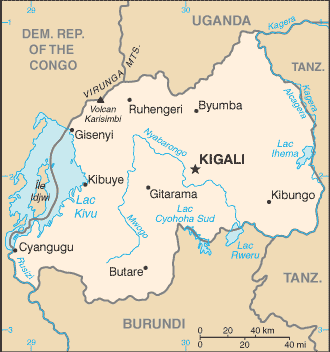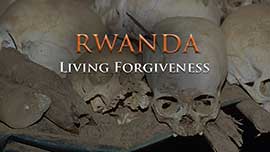GENOCIDE FLOWED FROM FEAR AND ETHNIC HATRED IN RWANDA

[Rwanda, CIA Factbook, public domain]
ALTHOUGH THE TUTSIS AND HUTUS in Rwanda spoke the same language, shared the same culture, and could not always be identified by differences in appearance, ethnic tensions were strong between them in the twentieth century. These were aggravated by land shortages and past rivalries, by earlier colonial discrimination—and by faulty church policies.
The minority Tutsi had ruled the country when European missions first arrived, and the missions sided with them. When the Hutu came to power (partly through the efforts of individual Catholic priests), the top hierarchy of the mainline churches realigned with the Hutu. Discrimination against Tutsi became strong within Catholic, Presbyterian, Anglican, and Seventh Day Adventist churches. (By contrast, the fast-growing Pentecostal movement rejected any power alignment and its members were less prone to join in racial rivalries.)
The majority Hutu in Rwanda massacred groups of Tutsis several times in the decades following Independence from colonialism. Tutsi exiles formed an army in nearby Uganda and attacked Rwanda several times, aggravating tensions. In neighboring Burundi, where Tutsis held the upper hand, they massacred 200,000 Hutus in 1972. In the 1980s and 1990s, the Hutu government of Rwanda, under fire for corruption, staged acts of violence that it blamed on Tutsis. According to international agencies, it also fomented violence and chaos that it then claimed was the result of multi-party efforts to reform the government. In this way it exploited and ramped up ethnic tension in a desperate gamble to retain power.
Although Rwanda’s mainline churches often spoke out against violence, they did so in general terms without identifying specific culprits. They urged support for the Hutu government. Many churchgoers took this as assent for Hutus to target Tutsis.
Someone shot down the airplane of Rwandan President Juvenal Habyarimana on this day, 6 April 1994. As if on cue, Hutu radicals rounded up and killed Tutsis and moderate Hutus in Kigali, the national capital. Over the next few days, Habyarimana’s successors sent operatives across the country in a pre-planned and coordinated effort to exterminate Tutsis. Government radio broadcasts incited killing.
What made the resulting genocide more horrifying was that killers and killed had worshiped together. In fact, many Hutu priests not only egged on the murders, but identified Tutsi parishioners and manned barricades to capture any who tried to escape. At Ngoma parish, Hutus went to the church each morning to pray before heading out to participate in the day’s slaughter.
The government’s method was to encourage Tutsi to gather for sanctuary in churches and schools (where in previous massacres Tutsi had been granted asylum) and then to slaughter them en masse. Ten or twenty thousand Tutsi might be killed at a single church. So many were killed in the church at Nyamata that survivors later converted it into a memorial for the murdered.
Over a period of three months, about 800,000 Tutsis were slaughtered, often with great cruelty. Tutsi survivors who had hidden in swamps spoke of drinking muddy water “enriched with the blood of the dead.” They told of Hutus hacking open pregnant women to kill their babies before their eyes. Attackers hacked off Tutsis’ limbs, rather than kill them outright, laughing and singing all the while; then left the wounded to die in agony over the course of two or three days.
Here and there Hutu individuals, especially among Pentecostal Christians, actively aided Tutsis. In the few parishes where Christian leaders actively opposed the violence, a smaller proportion of Tutsi died. Some Hutus even chose to die with Tutsis they were protecting. Timothy Longman, in Christianity and Genocide in Rwanda, tells of Félicitas Niyitegeka, a sixty-year-old nun, who rejected offers to spare her life, choosing to die with the people she was trying to protect. She was shot last.
The genocide did not cease until commander Paul Kagame’s Tutsi army invaded Rwanda from neighboring Uganda where it had been training. Kagame drove out the killers, toppled the Hutu regime, and established a new government with Pasteur Bizimungu, a Hutu, as president. However, Kagame soon jailed Bizimungu on accusations of instigating ethnic killing. Over a million Hutus fled to the Congo where international opinion tended to take their side. Violence continued because Rwanda warred against the Hutu refugees, many of whom had been involved in the massacres and were armed and militant.
Since the restoration of peace in Rwanda, Tutsis and Hutus worship together again, but not without suspicion. As one survivor remarked, “I know that all the Hutus who killed so calmly cannot be sincere when they beg for pardon, even of the Lord. For them the Tutsi will always be the enemy.”
—Dan Graves
----- ----- -----
Watch Rwanda: Living Forgiveness at RedeemTV

You can purchase Rwanda: Living Forgiveness at Vision Video.






